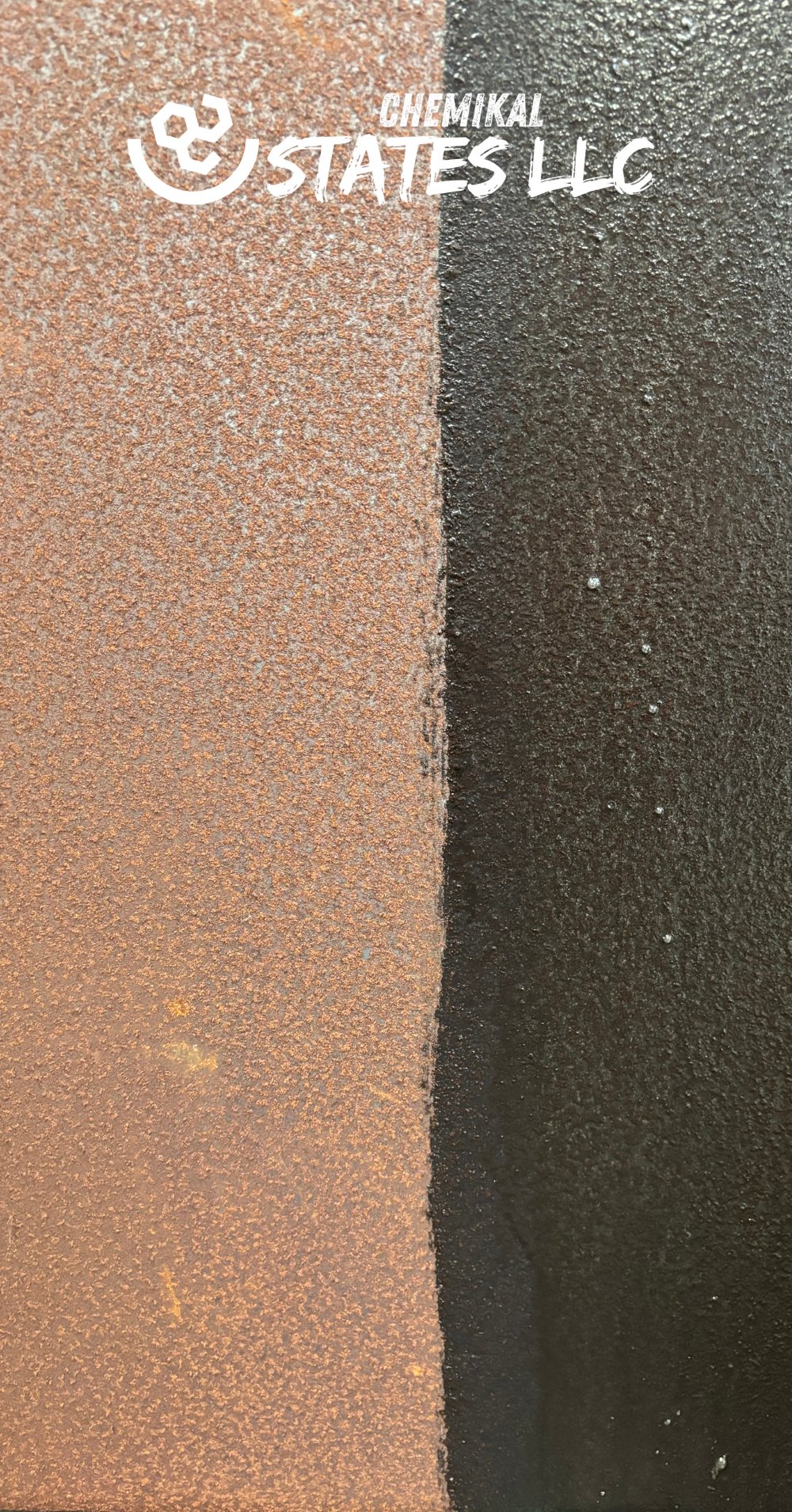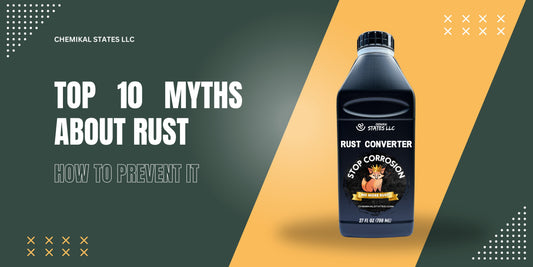
The Ultimate Guide to Using Rust Converter: Best Practices for Trucks, Cars, and More
Share
Rust is the enemy of metal surfaces, especially when it comes to vehicles like trucks and cars. Whether you’re restoring a classic car or maintaining your daily driver, rust can severely damage your vehicle’s structural integrity and appearance. The solution? A high-quality Rust Converter. In this comprehensive guide, we’ll cover everything you need to know about using Rust Converter, from how it works to the best application methods. We’ll also provide answers to frequently asked questions that will help you get the most out of this essential product.

What Is a Rust Converter and How Does It Work?
A Rust Converter is a chemical solution designed to stop rust in its tracks by converting iron oxide (rust) into a more stable compound, usually iron tannate. This chemical reaction not only neutralizes rust but also creates a paintable surface, making it easier to protect the metal from further corrosion. Unlike rust removers that strip away rust, Rust Converters work by chemically altering the rust, providing both immediate and long-term protection.
In a video shared by the client, they detailed the step-by-step process of how they applied the Rust Neutralizer to the sheet metal used in their installations:
How Does Rust Converter Work on Different Surfaces?
Rust Converter is particularly effective on ferrous metals like iron and steel. When applied to rusted metal, the product reacts with the iron oxide, converting it into a stable compound that won’t continue to corrode. This makes it ideal for use on:
- Truck and Car Frames: Especially useful for undercarriages and wheel wells that are frequently exposed to moisture and road salt.
- Large Metal Surfaces: Perfect for treating extensive rust on large surfaces such as industrial equipment or metal fencing.
- Classic Cars: Essential for restoring vintage vehicles where rust has taken hold over time.

How to Apply Rust Converter to Metal Surfaces
Applying Rust Converter is straightforward, but following the correct steps will ensure the best results. Here’s a step-by-step guide to applying Rust Converter to metal surfaces, whether you’re working on a small car part or a large truck frame.

Step 1: Surface Preparation
Before applying Rust Converter, it’s crucial to prepare the surface:
- Clean the Surface: Remove any loose rust, dirt, and grease using a wire brush or scraper. For heavily soiled areas, you may need to use a degreaser.
- Dry the Surface: Ensure that the metal surface is completely dry before applying the Rust Converter. Moisture can interfere with the chemical reaction and reduce effectiveness.

Step 2: Application Methods
Rust Converter can be applied using different methods depending on the size and location of the rusted area:
- Brush Application: Use a paintbrush for small, detailed areas. This method allows you to apply the Rust Converter precisely where it’s needed.
- Roller Application: For larger, flat surfaces, a roller can be used to apply the Rust Converter evenly and efficiently.
- Spray Application: Sprayers are ideal for large or hard-to-reach areas, such as the undercarriage of a truck. Ensure even coverage by moving the sprayer in a steady, overlapping motion.

Step 3: Allow the Converter to Work
Once applied, allow the Rust Converter to dry and react with the rust. This process typically takes 24 to 48 hours. During this time, the rust will darken as it is converted into a stable, non-corrosive compound.

Step 4: Finishing the Surface
After the Rust Converter has fully cured:
- Inspect the Surface: Check the treated area to ensure all rust has been converted. If any rust remains, apply a second coat.
- Paint the Surface: For best results, apply a primer followed by a topcoat of paint. This additional layer not only enhances the appearance but also provides further protection against rust.
Best Rust Converter for Trucks and Cars
When choosing a Rust Converter for your vehicle, it’s important to consider the product’s effectiveness on heavily rusted areas, ease of application, and long-term durability. Here are some factors to consider:
- Heavy Rust: For vehicles exposed to harsh conditions, such as trucks used in snowy regions, a Rust Converter that works best on heavy rust is essential. Look for products that can penetrate deep rust and create a strong protective layer.
- DIY Projects: If you’re a DIY enthusiast, opt for a Rust Converter that’s easy to apply with basic tools. Many products are available in spray form, making them convenient for quick touch-ups and large projects alike.
- Restoring Classic Cars: Vintage vehicles often have delicate parts that require careful restoration. Choose a Rust Converter that’s gentle enough for classic cars but strong enough to stop rust permanently.
Now the video is from our client in Poland, Europe.
Transform your rusted surfaces with ease!
Our Rust Converter is the ultimate solution for protecting your trucks, cars, and more. It not only stops rust in its tracks but also converts it into a durable, protective coating, ensuring your metal surfaces last longer. Perfect for any metal structure, our product is easy to apply and delivers professional results.
Ready to safeguard your investments? Scroll down the page to make your purchase and experience the difference today!
FAQs About Rust Converters
1. Best Rust Converter for Trucks and Cars
Q: What is the best Rust Converter for trucks and cars?
A: The best Rust Converter for vehicles is one that effectively neutralizes rust and provides a durable, paintable surface. Products like Chemikal States Rust Converter are highly recommended for their ease of use and long-lasting protection.
2. How to Apply Rust Converter to Metal Surfaces
Q: How do you apply Rust Converter to metal surfaces?
A: Start by cleaning and drying the metal surface. Apply the Rust Converter using a brush, roller, or sprayer, depending on the size of the area. Allow the product to dry for 24-48 hours before painting over it.
3. Best Rust Converter for Restoring Classic Cars
Q: What Rust Converter should I use for restoring classic cars?
A: For restoring classic cars, choose a Rust Converter that is strong enough to neutralize rust without damaging delicate parts. Look for products specifically designed for automotive restoration, like those offered by Chemikal States.
4. How to Use Rust Converter on Car Frame
Q: Can you use Rust Converter on a car frame?
A: Yes, Rust Converter is ideal for treating rust on car frames, especially in areas like the undercarriage and wheel wells. Ensure the frame is clean and dry before applying the product, and follow up with a protective topcoat.
5. Rust Converter That Works Best on Heavy Rust
Q: What Rust Converter works best on heavy rust?
A: For heavily rusted areas, choose a Rust Converter designed for deep penetration and long-lasting protection. The Chemikal States Rust Converter is particularly effective for tough rust conditions.
6. Where to Buy Rust Converter Online
Q: Where can I buy Rust Converter online?
A: You can purchase high-quality Rust Converters online at Chemikal States. They offer reliable shipping and top-rated products for all your rust treatment needs.
7. Rust Converter for Large Metal Surfaces
Q: Is Rust Converter effective on large metal surfaces?
A: Yes, Rust Converter is effective on large metal surfaces. For extensive rust, use a roller or sprayer to ensure even coverage. Always follow up with a protective coat of paint.
8. Best Rust Converter for DIY Projects
Q: What is the best Rust Converter for DIY projects?
A: For DIY projects, choose a Rust Converter that is easy to apply and offers strong rust protection. The Chemikal States Rust Converter is a great option for home use, providing professional results with minimal effort.
9. Rust Converter Application Tips for Vehicles
Q: What are some tips for applying Rust Converter to vehicles?
A: Ensure the vehicle surface is clean and dry before applying Rust Converter. Use a sprayer for large areas like the undercarriage and a brush for smaller details. Allow adequate drying time before painting.
10. Is Rust Converter Effective on Heavily Rusted Areas?
Q: Is Rust Converter effective on heavily rusted areas?
A: Yes, Rust Converter is effective on heavily rusted areas, but it may require multiple applications. Ensure that loose rust is removed before applying the product, and consider a second coat for the best results.
Conclusion: Protect Your Investment with the Best Rust Converter
Whether you’re maintaining a truck, restoring a classic car, or working on a DIY metal project, using the right Rust Converter can make all the difference. By following the steps outlined in this guide, you can effectively neutralize rust and protect your vehicle or metal surfaces from further damage. For top-quality Rust Converters that are trusted by professionals and DIY enthusiasts alike, visit Chemikal States today.










